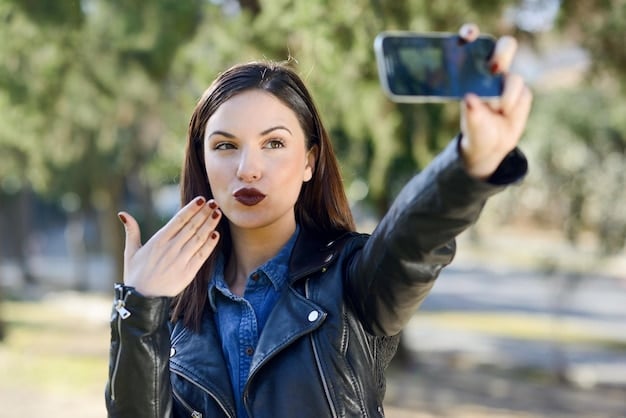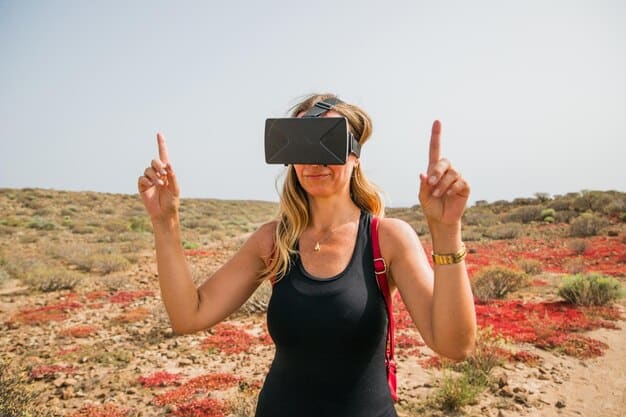Navigating the Evolving Landscape of Travel Influencer Marketing

Navigating the evolving landscape of influencer marketing in the travel industry requires understanding new technologies, shifts in social media, the demand for authentic content, and the importance of data-driven strategies to create successful campaigns.
The world of travel influencer marketing is constantly changing. To succeed, brands and influencers alike need to stay informed and adaptable. This article covers the essential aspects of
Understanding the Current State of Travel Influencer Marketing
To effectively navigate the evolving landscape of influencer marketing, it’s crucial to understand the current state of affairs. This involves recognizing the major shifts in consumer behavior, the rise of new platforms, and the increasing demand for authenticity.
The travel industry has always been heavily influenced by word-of-mouth recommendations, and social media has amplified this effect exponentially. Influencer marketing has become a powerful tool for travel brands to reach their target audience in a more personal and engaging way.
The Rise of Micro and Nano Influencers
One significant trend is the growing popularity of micro and nano influencers. These influencers have smaller but highly engaged audiences, offering a more authentic and relatable connection. Brands are increasingly partnering with them to tap into niche markets and build trust.
Instead of focusing solely on influencers with millions of followers, brands are recognizing the value of authentic engagement over sheer reach. Micro and nano influencers often have a deeper understanding of their audience’s preferences, making their recommendations more impactful.
Authenticity and Transparency
Consumers are becoming more discerning and are seeking authentic content. Transparency is key, and influencers need to disclose sponsored content clearly. Brands that prioritize genuine partnerships and avoid inauthentic practices are more likely to succeed.
- Disclosure: Clearly label sponsored content with hashtags like #ad or #sponsored.
- Genuine Content: Encourage influencers to share their honest experiences and opinions.
- Audience Alignment: Partner with influencers whose values align with the brand’s mission.
In summary, understanding the current state of travel influencer marketing requires recognizing the shift towards authenticity, the rise of micro and nano influencers, and the importance of transparency. Brands that adapt to these changes will be better positioned to succeed in this dynamic landscape.

Identifying Key Trends in Travel Influencer Marketing for 2025
Looking ahead to 2025, several key trends are shaping the future of travel influencer marketing. Staying ahead of these trends is essential for developing effective and innovative campaigns.
Technology is playing a major role in transforming how influencers create and share content. From virtual reality to augmented reality, new tools are emerging that offer immersive experiences for audiences.
The Metaverse and Virtual Travel Experiences
The metaverse is creating new opportunities for virtual travel experiences. Influencers can now take their audience on virtual tours of destinations, offering a glimpse into places they might not be able to visit physically. This is particularly relevant for reaching audiences who are unable to travel due to health concerns or financial limitations.
Virtual travel experiences also offer a sustainable alternative to traditional tourism, reducing the environmental impact of travel. Brands can partner with influencers to promote eco-friendly destinations and practices within the metaverse.
AI-Powered Influencer Marketing Tools
Artificial intelligence is revolutionizing influencer marketing, providing tools for identifying the right influencers, analyzing campaign performance, and predicting future trends. AI algorithms can help brands optimize their campaigns for maximum impact.
- Influencer Discovery: AI-powered tools can identify influencers who align with the brand’s values and target audience.
- Campaign Analysis: AI can analyze campaign data to identify what’s working and what’s not.
- Trend Prediction: AI algorithms can predict future trends in travel influencer marketing.
Identifying key trends in travel influencer marketing for 2025 involves understanding the impact of the metaverse, the role of AI-powered tools, and the increasing demand for immersive and personalized experiences. By embracing these trends, brands can create more engaging and effective campaigns.
Developing a Data-Driven Influencer Strategy
A data-driven influencer strategy is essential for measuring the ROI of influencer campaigns. By tracking key metrics and analyzing data, brands can optimize their campaigns for better results.
Data provides valuable insights into audience demographics, engagement rates, and conversion rates. This information can be used to refine targeting strategies and improve campaign performance.
Key Performance Indicators (KPIs) for Travel Influencer Marketing
Several KPIs can be used to measure the success of travel influencer campaigns. These include reach, engagement, website traffic, and conversion rates. By tracking these metrics, brands can determine the effectiveness of their campaigns.
Reach measures the number of people who have seen the influencer’s content. Engagement measures the level of interaction with the content, such as likes, comments, and shares. Website traffic measures the number of people who have visited the brand’s website as a result of the campaign. Conversion rates measure the number of people who have taken a desired action, such as making a purchase or booking a trip.
Using Analytics Tools to Track Campaign Performance
Various analytics tools can be used to track campaign performance. These tools provide detailed data on audience demographics, engagement rates, and conversion rates. Google Analytics, social media analytics, and influencer marketing platforms offer valuable insights into campaign performance.
- Google Analytics: Track website traffic and conversion rates.
- Social Media Analytics: Measure reach, engagement, and audience demographics.
- Influencer Marketing Platforms: Provide detailed data on influencer performance.
Developing a data-driven influencer strategy involves identifying key performance indicators, using analytics tools to track campaign performance, and analyzing data to optimize campaigns for better results. By leveraging data, brands can make informed decisions and maximize the ROI of their influencer marketing efforts.
Building Long-Term Relationships with Influencers
Building long-term relationships with influencers is crucial for creating authentic and impactful campaigns. These relationships are based on trust, mutual respect, and shared values.
Long-term partnerships allow influencers to become genuine advocates for the brand, resulting in more authentic and engaging content. These relationships also provide opportunities for collaboration and co-creation.
The Benefits of Long-Term Partnerships
Long-term partnerships offer several benefits. These include increased brand awareness, improved brand reputation, and higher engagement rates. Long-term relationships also allow influencers to develop a deeper understanding of the brand’s values and mission.
When influencers genuinely believe in the brand, their content is more authentic and impactful. This can lead to higher conversion rates and increased customer loyalty.
Strategies for Nurturing Influencer Relationships
Several strategies can be used to nurture influencer relationships. These include providing influencers with exclusive access to products and services, inviting them to events, and collaborating on content creation. It’s also important to communicate regularly with influencers and provide them with feedback on their content.
- Exclusive Access: Provide influencers with early access to new products and services.
- Event Invitations: Invite influencers to attend industry events and brand activations.
- Collaborative Content: Co-create content with influencers to showcase their expertise.
Building long-term relationships with influencers involves recognizing the benefits of these partnerships and implementing strategies for nurturing these relationships. By investing in long-term collaborations, brands can create more authentic and impactful campaigns that resonate with their target audience.

Staying Compliant with Advertising Regulations
Compliance with advertising regulations is essential for maintaining trust and credibility in influencer marketing. Brands and influencers need to adhere to guidelines set by regulatory bodies such as the Federal Trade Commission (FTC).
Transparency is key, and influencers need to disclose sponsored content clearly and prominently. Failure to comply with advertising regulations can result in fines and damage to brand reputation.
FTC Guidelines for Influencer Marketing
The FTC has issued guidelines for influencer marketing, requiring influencers to disclose their relationship with brands. These guidelines state that influencers must clearly and conspicuously disclose when they have been paid or have received free products or services in exchange for promoting a brand.
The FTC also requires that disclosures be made in a way that is easily noticeable and understandable to consumers. Disclosures should be placed near the endorsement and should be clear and unambiguous.
Best Practices for Disclosure and Transparency
Several best practices can be followed to ensure compliance with advertising regulations. These include using clear and prominent disclosures, avoiding deceptive practices, and monitoring influencer content for compliance.
- Clear Disclosures: Use hashtags like #ad, #sponsored, or #partner to clearly label sponsored content.
- Avoid Deception: Ensure that endorsements are truthful and not misleading.
- Monitor Compliance: Regularly monitor influencer content for compliance with advertising regulations.
Staying compliant with advertising regulations involves understanding the FTC guidelines, implementing best practices for disclosure and transparency, and monitoring influencer content for compliance. By prioritizing compliance, brands can maintain trust and credibility with their audience.
Measuring the ROI of Your Travel Influencer Campaigns
Measuring the return on investment (ROI) of travel influencer campaigns is essential for evaluating their effectiveness and justifying their cost. ROI can be measured by tracking key metrics and analyzing campaign data.
ROI provides valuable insights into the performance of influencer campaigns, helping brands make informed decisions about future investments. It also allows brands to optimize their campaigns for better results.
Calculating the ROI of Influencer Marketing
The ROI of influencer marketing can be calculated by comparing the cost of the campaign to the revenue generated as a result of the campaign. Several methods can be used to calculate ROI, including attribution modeling and sales lift analysis.
Attribution modeling involves assigning credit to different touchpoints in the customer journey, including influencer marketing. Sales lift analysis involves comparing sales before and after the influencer campaign to determine the impact of the campaign on sales.
Tools and Techniques for ROI Measurement
Various tools and techniques can be used for ROI measurement. These include Google Analytics, social media analytics, and influencer marketing platforms. These tools provide detailed data on campaign performance, allowing brands to calculate ROI accurately.
- Google Analytics: Track website traffic, conversion rates, and revenue.
- Social Media Analytics: Measure reach, engagement, and brand mentions.
- Influencer Marketing Platforms: Provide detailed data on influencer performance and ROI.
Measuring the ROI of travel influencer campaigns involves calculating the ROI using different methods, utilizing tools and techniques for ROI measurement, and analyzing data to optimize campaigns for better results. By focusing on ROI, brands can ensure that their influencer marketing efforts are delivering a positive return on investment.
| Key Point | Brief Description |
|---|---|
| 💡Micro-Influencers | Smaller, engaged audiences offer authentic connections. |
| 🌐 Metaverse Travel | Virtual tours create immersive experiences for a broader audience. |
| 🤖 AI-Driven Campaigns | AI tools analyze data for optimized influencer selection and performance. |
| 📊 Data-Driven ROI | Measure ROI using analytics tools to justify campaign costs. |
FAQ
▼
Influencer marketing in the travel industry involves collaborating with individuals who have a strong online presence and influence over their followers to promote travel destinations, products, or services. It leverages their reach and credibility to attract potential travelers.
▼
Authenticity is crucial because today’s consumers are discerning and value genuine experiences and recommendations. Influencers who provide honest and transparent content are more likely to build trust with their audience, leading to better engagement and conversions.
▼
Brands can measure ROI by tracking key metrics such as website traffic, engagement rates, conversion rates, and sales. Using analytics tools like Google Analytics and social media insights, they can attribute results to specific influencer activities and determine campaign effectiveness.
▼
The FTC requires influencers to clearly and conspicuously disclose any material connections with brands, such as sponsored posts or free products. Disclosures should be easily noticeable and understandable to consumers, ensuring transparency and compliance with advertising regulations.
▼
Brands can foster long-term relationships by offering exclusive access to products, inviting them to events, and collaborating on content creation. Regular communication, providing feedback, and genuinely valuing their partnership can strengthen trust and loyalty over time.
Conclusion
Navigating the evolving landscape of influencer marketing in the travel industry requires embracing new technologies, prioritizing authenticity, and developing data-driven strategies. By staying informed and adaptable, brands can create impactful campaigns that resonate with their target audience and drive meaningful results.





